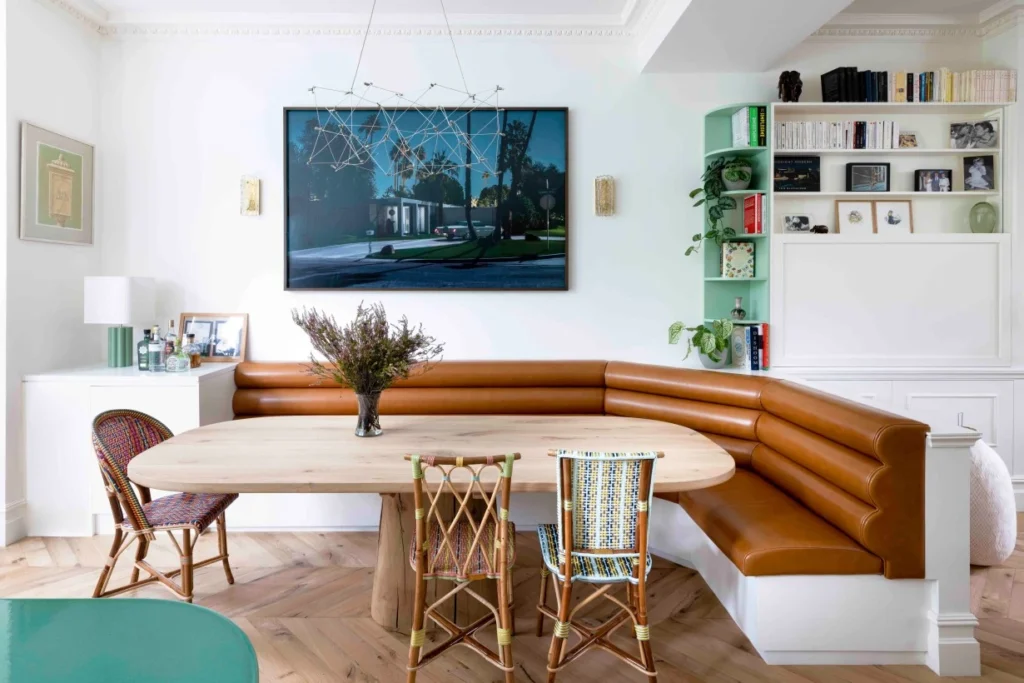Creating a banquette bench in a single day may sound ambitious, but with thoughtful planning, the right materials, and a can-do attitude, it’s absolutely achievable. The beauty of a banquette bench lies in its versatility—whether you’re tucking it into a breakfast nook, stretching it along one wall of your dining room, or nestling it under a sunny window, a banquette offers both charm and functionality. It maximizes space for seating, adds built-in storage, and brings a custom, high-end look to your home without the custom price tag. And yes, you can build it yourself.
Why Choose a Banquette Bench for Your Home
We choose a banquette bench not just for aesthetics but also for the practicality it brings into everyday life. Unlike standalone chairs, banquettes save valuable room in small kitchens or dining areas by nesting closely against the wall. They offer under-seat storage that’s perfect for stashing table linens, board games, or seasonal décor. Plus, with customized cushions and upholstery, they can easily tie into your home's entire theme—whether it’s mid-century, farmhouse, coastal, or minimalist.
For homeowners who treasure having a cozy corner to sip morning coffee or entertain guests, a banquette bench offers a timeless appeal. Adding one instantly defines a space and can become one of the most-used spots in your home.
Planning Your One-Day DIY Banquette Bench Build
Before picking up the power tools, it’s essential to plan thoroughly. With precise measurements and a clear list of needed materials, you’ll avoid unnecessary stress later on.
Measuring the Space
Start by identifying the area where your banquette will go. Measure the length, depth, and height you want your bench to be. A comfortable seat height is typically around 18 inches, while the depth can range between 16 and 24 inches depending on available space and comfort preference.
Pay close attention to window sills, baseboards, radiators, or any odd angles. If your bench is going into a corner, both walls need to be straight and true—or prepared to manage a few quirks if they are a bit off.
Design Choices
Ask yourself: will it have a backrest or sit flush against the wall? Will you include drawers or a lift-up seat for storage underneath? And what about the base—do you prefer a simple box, shaker paneling, or open cubby-style shelves?
If you're leaning toward a classic aesthetic, Shaker-style cabinets in kitchens might inspire your bench’s front design.
Tools and Materials Checklist
To complete your DIY banquette bench in a day, gather all materials and tools before you begin. A delay caused by a last-minute hardware store trip can quickly throw off your timeline.
Tools:
- Circular saw or miter saw
- Power drill/driver
- Nail gun (brad nailer)
- Measuring tape and T-square
- Level
- Clamps
- Stud finder
- Wood glue
- Sandpaper or power sander
Materials:
- 3/4" plywood (for the main bench frame)
- 1×4 or 1×6 boards (for face frame and trim)
- Hinges (if you're adding a lift-up seat)
- Wood screws and finishing nails
- Paint or wood stain
- Optional: Foam and fabric for cushion, baskets or bins for storage spaces
Step-by-Step Guide to Building Your DIY Banquette Bench
Step 1: Build the Base Frame
Using 2×4 lumber, create a sturdy rectangular frame that serves as the foundation of your bench. Secure pieces together with screws and wood glue, double-checking for levelness. If your floor slopes slightly—as many older homes do—you’ll want to shim appropriately.
Ensure the frame sits snug against the wall. Use a stud finder to locate wall studs and securely screw the frame into at least three of them to prevent any shifting over time.
Step 2: Attach the Box Structure
Cut your plywood panels to size and attach them to the frame to form the seat box. Use your nail gun or screws to secure the front and side panels. Sand down any rough edges. This is a good point to decide if you want internal dividers, open cubbyholes, or drawers instead of solid storage.
For a stylish twist with texture, consider applying fluted glass styles on cabinet above the banquette if it’s part of a larger built-in unit.
Step 3: Add the Bench Top
If you’re including storage beneath, plan your top in sections. The easiest route is hinged lift-up lids. Cut plywood panels to fit, attach a small rail under each so they rest evenly on the box structure, and install the hinges.
Sand all surfaces well. Lid edges should move freely and sit flush when closed.
Step 4: Trim and Finish the Front
Attach a face frame or trim boards to the front and sides of your bench. This will clean the edges and elevate the design beyond basic plywood construction. Secure with wood glue and finishing nails, then fill any holes or gaps with wood filler. Once dry, sand until smooth.
This step gives your banquette bench a polished, professional look—especially if it’s placed in a main living space or near the kitchen.
Step 5: Paint or Stain
Choose a color that complements your room. Soft neutrals like warm gray, classic white, or deep navy offer timeless appeal. If you're using the bench in a rustic or cottage-style setting, consider a light wash stain to highlight natural wood grain. Let the paint or stain dry completely before adding cushions or placing items on it.
Want to match the classic look of French Provincial furniture pieces? Add a soft white finish with light distressing on the corners for character.
Step 6: Add the Cushions
While not required for function, seat cushions dramatically increase comfort. They also pull together your room’s theme. You can either make custom foam cushions covered in upholstery fabric or repurpose pre-made bench cushions. Patterned covers can bring in seasonal flair, while neutral tones offer versatility all year.
Pair your new benched space with tall green accents for a lush corner—tall indoor plants work wonders in maximizing vertical interest in small or dimly lit dining areas.
Styling Your New Space
Now that you’ve built a banquette bench, let it shine within your space. Consider these simple styling tips to make the most of your new nook:
- Add a pedestal table in front for a classic breakfast setup.
- Hang pendant lighting or a vintage sconce overhead to anchor the nook visually.
- Layer throw pillows in various textures and patterns for both comfort and personality.
- Hang framed family photos, artwork, or even a chalkboard above the bench to make the area feel tied into daily life.
For homes with young children, selecting the best low-maintenance dogs for families could even build into the design—functional furniture like a banquette lets everyone gather in the same central spaces.
Common Pitfalls and How to Avoid Them
Even simple DIYs come with their share of challenges. Here are a few snags to watch out for:
- Not accounting for cushion height: An 18" tall bench becomes much taller with a thick cushion, making it less comfortable at a standard-height table.
- Skipping wall studs: Anchoring your bench securely prevents wobbles and guarantees longevity.
- Rushed cutting or measuring: The classic “measure twice, cut once” adage applies! Precision here sets the tone for the whole build.
- Ignoring ventilation: If using storage underneath, make sure it gets airflow—especially in humid areas.
For those tackling multiple renovations, knowing how much it costs to renovate a bathroom can help guide budgeting across projects—including your banquette build.
Final Thoughts
Building a DIY banquette bench in a day is a satisfying project that combines utility, comfort, and style. With careful planning, the right materials, and steady workmanship, you can create a custom seating area that brings character and functionality to your space. A thoughtful banquette becomes more than just a piece of furniture—it creates moments. Morning coffee by the window, family dinners gathered around a tight table, or catching up on emails from a cozy corner—all made more special with a little bit of DIY quality and personal touch. And all achievable, skillfully, in just one well-spent day.



